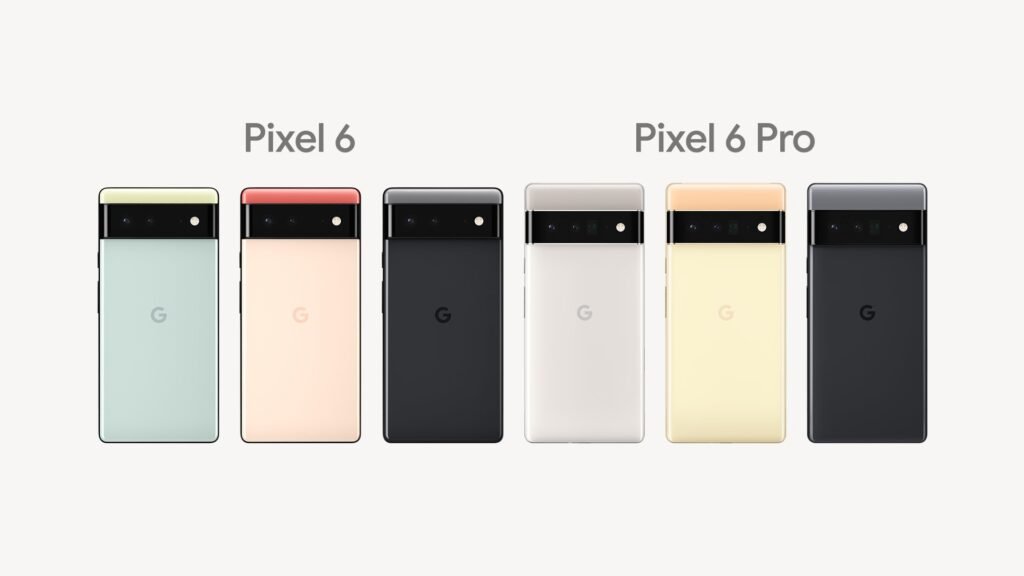After pivoting towards value with the Pixel 5, Google came roaring back into the high-end discussion in October 2021 with the Google Pixel 6 and Pixel 6 Pro. This generation represented a fundamental reset for the brand, introducing a bold new design language, significantly upgraded cameras, and most importantly, Google’s first-ever custom mobile chip: Google Tensor.
Design: Enter the Camera Bar

The Pixel 6 series shed the understated look of its predecessors for something instantly recognizable and distinct:
- The Camera Bar: Gone was the corner square module. Instead, a prominent black bar spanned the entire width of the phone’s back, housing the significantly larger camera sensors. This “Camera Bar” immediately became the Pixel 6’s defining visual feature.
- Premium Materials: Both phones featured Gorilla Glass Victus on the front and back, sandwiched around an aluminum frame (matte on the Pixel 6, polished on the 6 Pro), signifying a return to premium materials. Distinct two-tone color schemes appeared above and below the camera bar.
- In-Display Fingerprint Sensor: Google moved the fingerprint sensor from the back to under the display. It was an optical sensor, which unfortunately drew criticism early on for being slower and less reliable than competitors’ sensors or the previous capacitive sensors.
- Size and Shape: The Pixel 6 featured a flat 6.4-inch display, while the 6 Pro opted for a larger 6.7-inch display with curved edges.
- Durability: Both phones offered robust IP68 water and dust resistance. As expected by this point, the headphone jack was absent.
Hardware: Powered by Google Tensor
The biggest story was inside the phone:
- Google Tensor (Gen 1): For the first time, Google used its own custom-designed System-on-a-Chip (SoC). Co-developed with Samsung and built on a 5nm process, Tensor wasn’t designed to top raw CPU/GPU benchmark charts. Instead, Google focused its power on accelerating Artificial Intelligence (AI) and Machine Learning (ML) tasks directly on the device, powering new camera features, faster voice recognition, improved translation, and more. It also integrated the next-generation Titan M2 security chip.
- RAM & Storage: The Pixel 6 came with 8GB of RAM, while the 6 Pro boasted a hefty 12GB. Storage options used fast UFS 3.1 technology (128/256GB for Pixel 6; 128/256/512GB for 6 Pro).
- Displays: Both featured excellent OLED panels. The Pixel 6 had a smooth 90Hz refresh rate (FHD+), while the Pixel 6 Pro leveled up with a 10-120Hz variable refresh rate LTPO display (QHD+) for even smoother motion and potential battery savings.
- Battery & Charging: Battery sizes saw a welcome increase (4614mAh for Pixel 6, 5003mAh for 6 Pro). Google advertised 30W wired charging, although independent tests showed actual sustained speeds were closer to 21-23W. Wireless charging (up to 21/23W with the new Pixel Stand) and reverse wireless charging returned.
Cameras: Bigger Sensors, More Lenses (on Pro)
The Pixel 6 series marked the first major camera hardware upgrade in years:
- New Main Sensor: Both phones shared a much larger 50MP main camera sensor (capturing significantly more light) with OIS and laser autofocus.
- Ultrawide Consistency: Both also included a 12MP ultrawide camera.
- Pro Gets Telephoto: The Pixel 6 Pro exclusively added a 48MP telephoto lens with 4x optical zoom, utilizing a periscope design for extended reach.
- Front Cameras: The Pixel 6 had an 8MP front camera, while the 6 Pro featured a higher-resolution 11.1MP ultrawide selfie camera.
- Tensor-Powered Magic: The new Tensor chip enabled impressive new software features:
- Magic Eraser: Allowed users to easily remove unwanted objects or people from photos in Google Photos.
- Face Unblur: Combined images from the main and ultrawide sensors to sharpen faces that might have been blurred due to motion.
- Real Tone: Algorithms tuned to more accurately and beautifully represent diverse skin tones.
- Motion Mode: Created artistic blur effects like Action Pan (blurring the background behind a moving subject) and Long Exposure (blurring moving elements like water or light trails).
Software: Android 12 and Material You
The Pixel 6 series launched with Android 12 and its revolutionary Material You design language:
- Dynamic Theming: The phone’s UI colors (menus, buttons, icons, widgets) automatically adapted to match the user’s chosen wallpaper, creating a deeply personalized look.
- Enhanced AI: Tensor powered faster, more accurate on-device speech recognition for voice typing and commands, as well as improved Live Translate capabilities.
- Update Promise: Google committed to 3 years of major OS updates and 5 years of security updates.
Reception and Legacy: A Bold (Sometimes Buggy) Reboot
The Pixel 6 and 6 Pro were met with generally positive reviews, praised for their unique and bold design, excellent camera systems (especially the new features enabled by Tensor), smooth displays, and competitive launch prices ($599/$899).
However, the launch was marred by numerous software bugs and inconsistencies, leading to frustration for some early adopters. The performance of the optical fingerprint sensor was a frequent complaint, and some users reported issues with cellular connectivity/modem performance. While Tensor excelled at AI tasks, it didn’t always match the raw gaming performance of contemporary Snapdragon chips, and the charging speeds didn’t quite live up to the “30W” marketing.
Despite the initial hurdles (many of which were addressed via software updates), the Pixel 6 generation marked a successful and crucial turning point. It established a strong new design identity, proved Google could create capable custom silicon focused on AI, and delivered innovative camera features that reinforced the Pixel’s imaging prowess. It set the stage for the future direction of the entire Pixel lineup.
